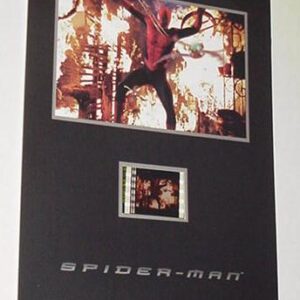Amazing Spider-Man Lithograph w/ Art by John Romita Sr AND Jr SIGNED by BOTH!
$24.99
Description
Amazing Spider-Man Lithograph w/ Art by John Romita Sr AND Jr SIGNED by BOTH! The Romitas are one of the most impressive family dynasties in the world of comic book art. John Romita Sr. has drawn every major Marvel character including Spider-Man. As artist, plot consultant, and senior art director, Romita became an institution at Marvel Comics. Today, John Romita Jr. continues the tradition at Marvel and his work on Spider-Man, the Hulk, Kick-Ass, Wolverine: Enemy of the State and more.
Most people could not afford to own an original piece of artwork by Picasso or Daniel Acuña, but having a copy of their masterworks wouldn’t be such a bad idea. This is where the idea of a lithograph comes into play. A lithograph is an authorized copy of an original work created by the artist himself or other skilled craftsmen. A lithograph is rarely worth more than the original artwork it reproduces, but if the print quality is excellent and the production numbers are low, it may still have significant value in the art world.
This image is clearly a Romita ‘take’ on Jack Kirby’s Amazing Fantasy # 15 cover, the first appearance of the Amazing Spider-Man. The paper around the image has a diamond-cut, indented feel to it. As you can see the litho is still in it’s polybag and is in near mint condition. Signed by both John Romita and John Romita Jr!
John V. Romita, Sr. (often known as simply John Romita) (born January 24, 1930) is an American comic-book artist best known for his work on Marvel Comics’ The Amazing Spider-Man. He was inducted into the Will Eisner Comic Book Hall of Fame in 2002. Marvel editor Stan Lee had heard of Romita’s leaving DC, and asked to see him. At “a three-hour lunch”, Romita recalled, Lee promised to match the agency salary if Romita would come work for Marvel, and to give him flexibility to work at home or at the office on any given day at Romita’s discretion. “I had inked an Avengers job for Stan, and I told him I just wanted to ink. I felt like I was burned out as a penciler after eight years of romance work. I didn’t want to pencil any more; in fact, I couldn’t work at home any more — I couldn’t discipline myself to do it. He said, “Okay,” but the first chance he had he shows me this Daredevil story somebody had started and he didn’t like it, and he wanted somebody else to do it. “He showed me Dick Ayers’ splash page for a Daredevil and asked me, ‘What would you do with this page?’ I showed him on a tracing paper what I would do, and then he asked me to do a drawing of Daredevil the way I would do it. I did a big drawing of Daredevil … just a big, tracing-paper drawing of Daredevil swinging. And Stan loved it.” Romita began a brief stint on Daredevil beginning with issue #12 (Jan. 1966), initially penciling over Jack Kirby’s dynamic layouts as a means of learning Marvel’s storytelling house style. Sales perked; while the title had a smaller print run than Marvel flagships The Amazing Spider-Man and Fantastic Four, it briefly boosted the company’s highest percentage sales. It also proved to be a stepping-stone for Romita’s signature, years-long penciling run on The Amazing Spider-Man. “What Stan Lee wanted was for me to do a two-part Daredevil story issues #16-17, May–June 1966 with Spider-Man as a guest star, to see how I handled the character”. The reason for the backdoor tryout was the growing estrangement between Spider-Man co-creators Stan Lee and Steve Ditko. When Ditko abruptly left Marvel after completing The Amazing Spider-Man #38 (July 1966), Lee gave Romita the assignment. This followed Romita’s eight-issue Daredevil run, the cover of the subsequent issue #20 (Sept. 1966), and an incidental Hulk and two Captain America stories (in Tales to Astonish #77, March 1966, and Tales of Suspense #76-77, April–May 1966, respectively). While Romita’s depiction of Spider-Man would eventually become the company mascot and the definitive look to the general public, the artist had trepidations: “I was hoping against it, believe it or not. People laugh when I say this, but I did not want to do Spider-Man. I wanted to stay on Daredevil. The only reason I did Spider-Man was because Stan asked me and I felt that I should help out, like a good soldier. I never really felt comfortable on Spider-Man for years. …I felt obliged to mimic Ditko because … I was convinced, in my own mind, that he was going to come back in two or three issues. … I couldn’t believe that a guy would walk away from a successful book that was the second-highest seller at Marvel. … After six months, when I realized it wasn’t temporary, I finally stopped trying to mimic Ditko. …I was doing these nine-panel pages and the thin line, and I was doing Peter Parker without any bone structure — just like Ditko was doing, I thought.” Romita took over The Amazing Spider-Man with issue #39 (Aug. 1966). The Amazing Spider-Man had been Marvel’s second-best-selling title at the time Romita began drawing it. Within a year, it overtook Fantastic Four to become the company’s top seller. Romita designed the look of Mary Jane Watson, a supporting character in the Spider-Man series who would later become the lead character’s romantic interest. Romita has stated that in designing Mary Jane, he “used Ann-Margret from the movie Bye Bye Birdie as a guide, using her coloring, the shape of her face, her red hair and her form-fitting short skirts.” Mary Jane Watson made her first full appearance in The Amazing Spider-Man #42 (Nov. 1966), although she first appeared in #25 (June 1965) with her face obscured and had been mentioned since #15 (Aug. 1964). Peter David wrote in 2010 that Romita “made the definitive statement of his arrival by pulling Mary Jane out from behind the oversized potted plant that blocked the readers’ view of her face in issue #25 and placing her on panel in what would instantly become an iconic moment.” Other characters which debuted in the Lee-Romita era include the Rhino in #41 (Oct. 1966), the Shocker in #46 (March 1967), and the Kingpin in #50 (June 1967). Lee and Romita’s stories focused as much on the social and college lives of the characters as they did on Spider-Man’s adventures. The stories became more topical, addressing issues such as the Vietnam War, political elections, and student activism. Romita suggested to writer Gerry Conway that supporting character Gwen Stacy should die at the hands of the Green Goblin in “The Night Gwen Stacy Died” in issue #121 (June 1973).484950 Her demise and the Goblin’s apparent death one issue later formed a story arc widely considered as the most defining in the history of Spider-Man. In his original run on The Amazing Spider-Man, Romita contributed a string of over 50 covers and an almost unbroken run of story layouts or full pencil-art for 46 issuesNote 2 as well as a 21-page story in The Amazing Spider-Man Annual #3 (Nov. 1966), the covers of Annuals #5-7, and the covers and stories for the two issues of the magazine-format title The Spectacular Spider-Man (July and Nov. 1968) that themselves totaled 110 story pages, the equivalent of five-and-a-half issues. As comics-art historian Daniel Herman assessed of Romita’s Spider-Man work, “Romita’s transformation of the character redefined the character’s look and took the strip in a different direction. It also made him a star artist in the comic book world. The trouble was, Romita took Spidey away from his roots and firmly planted him in the mainstream. … Marvel staffers would joke that Romita “took Spider-Man uptown”. Romita reinvented the character and made it possible for Spider-Man to appeal to a wider audience, even if he removed the qualities that had made the strip a surreal standout. Romita was the artist for the Spider-man newspaper comic strip from its launch on January 3, 1977 through late 1980.
John Salvatore Romita, Jr. (born August 17, 1956) is an American comic book artist best known for his extensive work for Marvel Comics from the 1970s to the 2010s. He is often referred to as JRJR, the abbreviation of John Romita, Jr. John Romita, Jr.’s first contribution to Marvel Comics was at the age of 13 with the creation of the Prowler in The Amazing Spider-Man #87 (Nov. 1969). Romita, Jr. began his career at Marvel UK, doing sketches for covers of reprints as a favor thanks to his respected father. His American debut was with a six page story entitled “Chaos at the Coffee Bean!” in The Amazing Spider-Man Annual #11 (1977). Romita’s early popularity began with his run on Iron Man with writer David Michelinie and artist Bob Layton which began in 1978. In the early 1980s, he had his first regular run on the series The Amazing Spider-Man and also was the artist for the launch of the Dazzler series. He and writer Dennis O’Neil introduced Madame Web in The Amazing Spider-Man #210 (Nov. 1980) and Hydro-Man in issue #212 (Jan. 1981). Working with writer Roger Stern on The Amazing Spider-Man, he co-created the character Hobgoblin. From 1983 to 1986 he had a run on the Uncanny X-Men with Dan Green and author Chris Claremont and co-created Forge. He would return for a second cat run on Uncanny X-Men in 1993. From 1988 to 1990, Romita enjoyed an extended stint on Daredevil with writer Ann Nocenti and inker Al Williamson, which included the creation of long-running Daredevil nemesis Typhoid Mary. For Romita himself, his stint on Daredevil was most significant for being both the first time he was allowed to do full pencils instead of just breakdowns, and the first time he had a working relationship with the writer on a series. He later remarked that “I finally felt like I was part of the creation process for the first time while I was on DD.” He worked on a host of Marvel titles during the 1990s, including a return to Iron Man for the second “Armor Wars” story arc, written by John Byrne; The Punisher War Zone; the Cable miniseries; and the Punisher/Batman crossover. Klaus Janson was a frequent inker. Romita collaborated with Frank Miller on a Daredevil origin story entitled Daredevil: The Man Without Fear in 1993, a revisiting of the character’s origin, with Williamson again on inks. Romita had to draw new transitional pages as the story changed formats from a 64-page graphic novel to a 144-page graphic novel to a five-issue limited series. Dan Jurgens and Romita, Jr. relaunched the Thor series in July 1998 while a January 1999 reboot of Peter Parker: Spider-Man was handled by Howard Mackie and Romita, Jr. In 2001, Romita returned to Spider-Man for a collaboration with writer J. Michael Straczynski beginning with The Amazing Spider-Man vol. 2 #30 (June 2001). The creative team produced a story for issue #36 (Dec. 2001) that served as memorial to the victims of the September 11 attacks. He drew Marvel’s Wolverine with author Mark Millar. In 2004, Romita’s creator-owned project The Gray Area was published by Image Comics. Romita’s art has since appeared in Black Panther, The Sentry and “Ultimate Vision”, a backup feature in the Ultimate Marvel line, written by Mark Millar. In 2006, Romita collaborated with writer Neil Gaiman on a seven-issue miniseries reinterpretation of Jack Kirby’s characters the Eternals. Romita worked with Greg Pak on the five-issue flagship comic of Marvel’s 2007 crossover storyline, World War Hulk. In 2008, Romita again returned to The Amazing Spider-Man. He also collaborated once more with Millar, for a creator-owned series, Kick-Ass, published by Marvel’s Icon imprint. This was later adapted into the 2010 film Kick-Ass. Romita, one of the producers, directed an animated flashback sequence in the film. Romita’s art influences include his father John Romita, Sr., as well as comics artists Jack Kirby and John Buscema, the Wyeth family of painters, and illustrator Charles Dana Gibson.
Near mint condition.

















